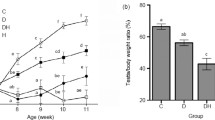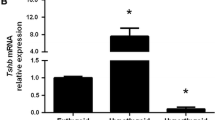Abstract
The effect of increased serum levels of thyroid hormone (triiodothyronine, T3) on young rat testis spermatogenesis was studied by analysing molecular and morphological parameters. Hyperthyroidism was induced by either T3-treatment or 2- and 10-day cold exposure. The poly(ADP-ribosyl)ation of proteins catalysed by poly(ADP-ribose) polymerase, which is particularly active at specific stages of rat spermatogenesis, was analysed as molecular index of DNA damage and cell stress. Poly(ADP-ribose) polymerase activity rose after both T3-treatment and 2- and 10-day cold exposure, with a trend of 10-day cold-exposed rats towards control values. In all hyperthyroid rats poly(ADP-ribose) turnover, as a contribution of both poly(ADP-ribose) polymerase and poly(ADP-ribose) glycohydrolase), was enhanced with respect to euthyroid animals. Poly(ADP-ribosyl)ation of proteins occurred with long and branched polymers suggesting an increased involvement of the modification system in DNA repair. Morphological changes of germ tissue were observed in hyperthyroid rats, mainly a high reduction of mature cells in the seminiferous tubule, and evidence of germ cell apoptosis was obtained by TUNEL method. In control animals germ cell apoptosis was within physiological levels. Conversely, in hyperthyroid rats a dramatic increase in the number of TUNEL-positive cells (some spermatogonia and numerous primary spermatocytes) was found, even though the increase was lower in 10-day than in 2-day cold-exposed animals.





Similar content being viewed by others
References
Meistrich ML, Trostle-Weige PK, van Beek MEAB (1994) Separation of specific stages of spermatids from vitamin A-synchronized rat testes for assessment of nucleoprotein changes during spermiogenesis. Biol Reprod 51:334–344. doi:10.1095/biolreprod51.2.334
Marcon L, Boissoneault G (2004) Transient DNA strand breaks during mouse and human spermiogenesis: new insights in stage-specificity and link to chromatin remodelling. Biol Reprod 70:910–918. doi:10.1095/biolreprod.103.022541
Sinha Hikim AP, Lue Y, Yamamoto CM, Vera Y, Rodriguez S, Yen PH, Soeng K, Wang C, Swerdloff RS (2003a) Key apoptotic pathways for heat-induced programmed germ cell death in the testis. Endocrinology 144(7):3167–3175. doi:10.1210/en.2003-0175
Sinha Hikim AP, Lue Y, Diaz-Romero M, Yen PH, Wang C, Swerdloff RS (2003b) Deciphering the pathways of germ cell apoptosis in the testis. J Steroid Biochem Mol Biol 85:175–182. doi:10.1016/S0960-0760(03)00193-6
Cai L, Hales BF, Robaire B (1997) Induction of apoptosis in the germ cells of adult male rats after exposure to cyclophosphamide. Biol Reprod 56:1490–1497. doi:10.1095/biolreprod56.6.1490
Lee J, Richburg JH, Shipp EB, Meistrich ML, Boekelheide K (1999) The Fas system, a regulator of testicular germ cell apoptosis, is differentially up-regulated in Sertoli cells versus germ cell injury of the testis. Endocrinology 140:852–858. doi:10.1210/en.140.2.852
Faraone-Mennella MR, De Lucia F, Gentile N, Quesada P, Farina B (1999) In vitro poly(ADP-ribosyl)ated histones H1a and H1t modulate rat testis chromatin condensation differently. J Cell Biochem 76:20–29. doi:10.1002/(SICI)1097-4644(20000101)76:1<20::AID-JCB3>3.0.CO;2-Y
Meyer-Ficca ML, Scherthan H, Burkle A, Meyer RG (2005) Poly(ADP-ribosyl)ation during chromatin remodelling steps in rat spermiogenesis. Chromosoma 114:67–74. doi:10.1007/s00412-005-0344-6
Dantzer F, Mark M, Quenet D, Scherthan H, Huber A, Liebe B, Monaco L, Chicheportiche A, Sassone-Corsi P, de Murcia G, Menissier-de Murcia J (2006) PARP-2 contributes to the fidelity of male meiosis and spermiogenesis. Proc Natl Acad Sci USA 103:14854–14859. doi:10.1073/pnas.0604252103
Schreiber V, Dantzer F, Ame JF, de Murcia G (2006) Poly(ADP-ribose): novel functions for an old molecule. Natl Rev 7:517–528. doi:10.1038/nrm1963
Hassa PO, Haenni SS, Elser M, Hottiger MO (2006) Nuclear ADP-ribosylation reactions in mammalian cells: where are we today and where are we going? Microbiol Mol Biol Rev 70:789–829. doi:10.1128/MMBR.00040-05
Althaus FR (2005) Poly(ADP-ribose): a co-regulator of DNA methylation? Oncogene 24(1):11–12. doi:10.1038/sj.onc.1208382
Faraone-Mennella MR (2005) Chromatin architecture and functions: the role(s) of poly(ADP-ribose) polymerase and poly(ADP-ribosyl)ation of nuclear proteins. Biochem Cell Biol 83(3):396–404. doi:10.1139/o05-042
Kim MY, Zhang T, Kraus WL (2006) Poly(ADP-ribosyl)ation by PARP-1: PAR-laying NAD+ into a nuclear signal. Genes Dev 19:1951–1967. doi:10.1101/gad.1331805
Cesarone CF, Scarabelli L, Demori I, Balocco S, Fugassa E (2000) PARP is affected early by thyroid state during liver regeneration in rats. Am J Physiol Gastrointest Liver Physiol 279:G1219–G1225
Jackowski G, Kun E (1983) The effect of in vivo treatment with T3 on the in vitro synthesis of proteinpoly(ADPR) adducts by isolate cardiocyte nuclei and the separation of poly(ADPribosyl)ated proteins by phenol extraction and electrophoresis. J Biol Chem 258:12587–12593
Ichikawa K, Hashizume K (1991) Cellular binding proteins of thyroid hormones. Life Sci 49:1513–1522. doi:10.1016/0024-3205(91)90323-4
Bouterfa HL, Piedrafita FJ, Doenecke D, Pfahl M (1995) Regulation of H1° gene expression by nuclear receptors through an unusual response element: implications for regulation of cell proliferation. DNA Cell Biol 14:909–919
Oppenheimer JH, Schwartz HL, Mariash CN, Kinlaw WB, Wong NCW, Freake HC (1987) Advances in our understanding of thyroid hormone action at the cellular level. Endocr Rev 8:288–308
Arambepola NK, Bunick D, Cooke PS (1998) Thyroid hormone effects on androgen receptor messenger RNA expression in rat Sertoli and peritubular cells. J Endocrinol 156:43–50. doi:10.1677/joe.0.1560043
Canale D, Agostini M, Giorgilli G, Cagliaresi C, Scartabelli G, Nardini V, Tannini EA, Martino E, Pinchera A, Macchia E (2001) Thyroid hormone receptors in neonatal, prepubertal, and adult rat testis. J Androl 22(2):284–288
Cooke PS, Zhao YD, Bunick D (1994) Triiodothyronine inhibits proliferation and stimulates differentiation of cultured neonatal Sertoli cells: possible mechanism for increased adult testis weight and sperm production induced by neonatal goitrogen treatment. Biol Reprod 51(5):1000–1005. doi:10.1095/biolreprod51.5.1000
Ariyaratne HB, Mendis-Handagama SM, Mason JI (2000) Effects of tri-iodothyronine on testicular interstitial cells and androgen secretory capacity of the prepubertal rat. Biol Reprod 63(2):493–502
Sahoo DK, Bhanja S, Chainy GB (2005) Experimental hyperthyroidism-induced oxidative stress and impairment of antioxidant defence system in rat testis. Indian J Exp Biol 43(11):1058–1067
D’Armiento M, Jannini EA (1992) Thyroid hormone action. In: Troncone L, Shapiro B, Satta MA, Monaco F (eds) Thyroid disease: basic science, pathology, clinical and laboratory diagnoses. CRC Press, Boca Raton, FL, pp 145–154
Jannini EA, Ulisse S, D’Armiento M (1995) Thyroid hormone and male gonadal function. Endocr Rev 16:443–459. doi:10.1210/er.16.4.443
Ben Saad MM, Maurel DL (2004) Reciprocal interaction between seasonal testis and thyroid activity in Zembra island rabbits (O. cuniculus): effects of castration, thyroidectomy temperature and photoperiod. Biol Reprod 70:1001–1009. doi:10.1095/biolreprod.103.020008
Quesada P, Farina B, Jones R (1990) Poly(ADP-ribosylation) of nuclear proteins in rat testis correlates with active spermatogenesis. Biochim Biophys Acta 1007:167–175
Faraone-Mennella MR, Roma G, Farina B (2003) Active poly(ADP-ribose) metabolism in DNase- and salt resistant rat testis chromatin with high transcriptional activity/competence. J Cell Biochem 89(4):688–697. doi:10.1002/jcb.10552
Nejad IF, Bollinger JA, Mitnich M, Reichlin S (1972) Importance of T3 (triiodothyronine) secretion in altered states of thyroid function in the rat: cold exposure, subtotal thyroidectomy, and hypophysectomy. Trans Assoc Am Physicians 85:295–308
Fregly MJ (1989) Activity of the hypothalamic-pituitary-thyroid axis during exposure to cold. Pharmacol Ther 41:85–142. doi:10.1016/0163-7258(89)90103-4
de Martino Rosaroll P, Venditti P, Di Meo S, De Leo T (1996) Effect of cold exposure on electrophysiological properties of rat heart. Experientia 52:577–582. doi:10.1007/BF01969732
Venditti P, De Leo T, Di Meo S (1997) Vitamin E administration attenuates the tri-iodothyronine-induced modification of heart electrical activity in the rat. J Exp Biol 200:909–914
Brown BL, Ekins RP, Ellis SM, Reith WS (1970) Specific antibodies to triiodothyronine hormones. Nature 226:359. doi:10.1038/226359a0
Ben-Sasson SA, Sherman Y, Gavrielly Y (1995) Identification of dying cells. Methods Cell Biol 46:29–39. doi:10.1016/S0091-679X(08)61922-6
Harlow E, Lane D (eds) (1988) Antibodies: a laboratory manual. Cold Spring Harbor, New York
Pacheco-Rodriguez G, Alvarez-Gonzalez R (1999) Measurement of poly(ADP-ribose) glycohydrolase activity by high resolution polyacrylamide gel electrophoresis: specific inhibition by histones and nuclear matrix proteins. Mol Cell Biochem 193:13–18. doi:10.1023/A:1006927119100
Panzeter PL, Althaus FR (1990) High resolution size analysis of ADP-ribose polymers using modified DNA sequencing gels. Nucleic Acids Res 18(8):2194. doi:10.1093/nar/18.8.2194
Keith G, Desgres J, de Murcia G (1990) Use of 2D-thin layer chromatography for the components study of poly(ADP-ribose). Anal Biochem 191:309–313. doi:10.1016/0003-2697(90)90224-W
Bernardi R, Rossi L, Poirier GG, Scovassi AI (1997) Analysis of poly(ADP-ribose) glycohydrolase activity in nuclear extracts from mammalian cells. Biochim Biophys Acta 1338:60–68
Burton K (1956) A study of the conditions and mechanism of diphenylamine reaction for the colorimetric estimation of DNA. Biochem J 62(2):315–323
Sambrook J, Fritsch EF, Maniatis T (eds) (1989) Molecular cloning: a laboratory manual. Cold Spring Harbor Laboratory Press, Cold Spring Harbor, NY
Buitrago JM, Diez LC (1987) Serum hormones and seminal parameters in males with thyroid disturbance. Andrologia 19(1):37–41
Clyde HR, Walsh PC, English RW (1976) Elevated plasma testosterone and gonadotropin levels in infertile males with hyperthyroidism. Fertil Steril 27(6):662–666
Manna PR, Kero J, Tena-Sempere M, Pakarinen P, Stocco DM, Huhtaniemi T (2001) Assessment of mechanisms of thyroid hormone action in mouse Leydig cells: regulation of the steroidogenic acute regulatory protein, steroidogenesis and luteinizing hormone receptor function. Endocrinology 142(2):319–331. doi:10.1210/en.142.1.319
Faraone-Mennella MR, Ferone A, Ingino R, Cardone A, Venditti P, Di Meo S, Farina B (2005) Poly-ADPribosylation of proteins in hyperthyroid rat testes. In: Curtin N (ed) Poly(ADP-ribose) polymerases: bench to bedside. PARP conference 2005. Gateshead, Newcastle, UK, October 2005. Med Sci Monit 11(S 1):35
Aruldhas MM, Valivullah HM, Srinivasan N, Govindarajulu P (1986) Role of thyroid on testicular lipids in prepubertal, pubertal and adult rats. I. Hyperthyroidism. Biochim Biophys Acta 881(3):462–469
Acknowledgments
This work was financially supported by Ministero Istruzione, Universita’ e Ricerca (MIUR; Progetti di Rilevante Interesse Nazionale, PRIN 2003/2005). We wish to thank Dr Elena Porzio for technical assistance.
Author information
Authors and Affiliations
Corresponding author
Rights and permissions
About this article
Cite this article
Faraone-Mennella, M.R., Ferone, A., Marino, L. et al. Poly(ADP-ribosyl)ation of proteins and germ cell development in hyperthyroid rat testes. Mol Cell Biochem 323, 119–129 (2009). https://doi.org/10.1007/s11010-008-9970-7
Received:
Accepted:
Published:
Issue Date:
DOI: https://doi.org/10.1007/s11010-008-9970-7




